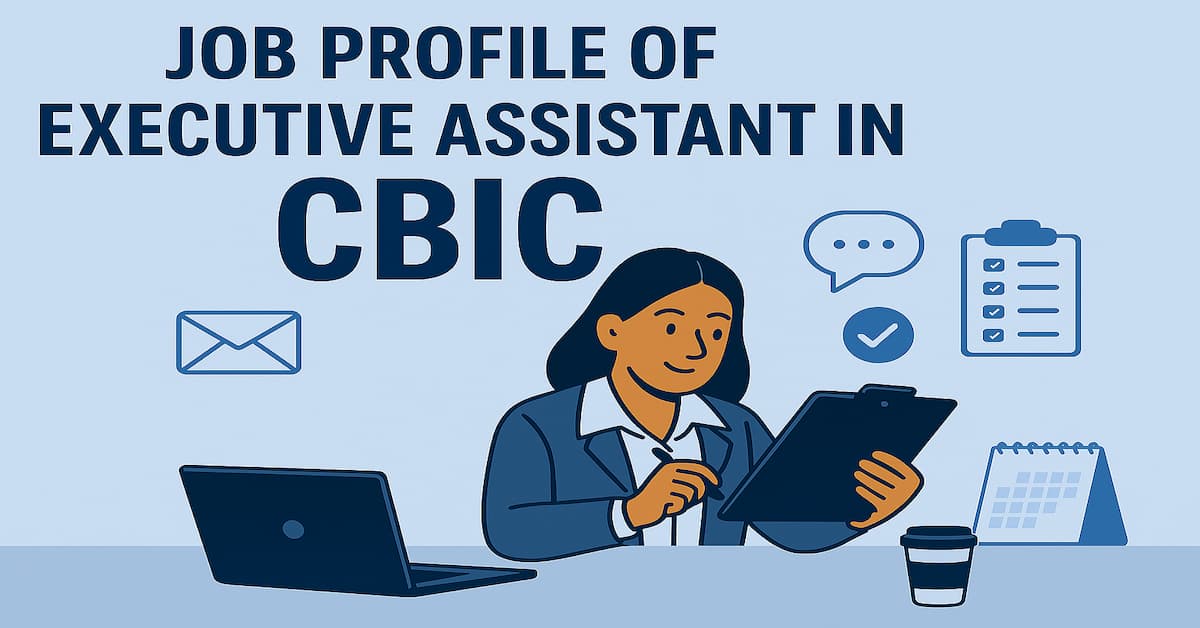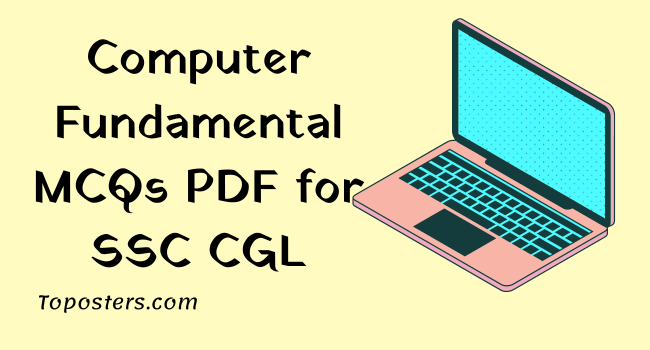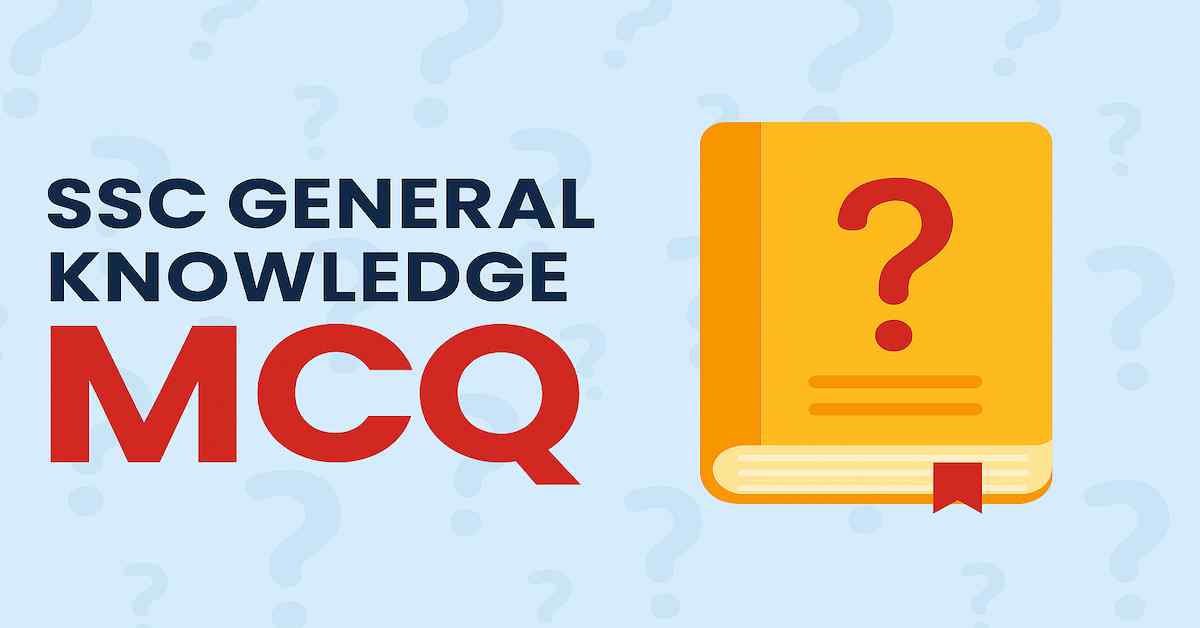If you are preparing for SSC CGL, you must understand the Executive Assistant in CBIC job profile. This is a relatively new post introduced in SSC CGL 2022. It has replaced the earlier designation of Senior Tax Assistant (STA).
Since it’s a new designation, many aspirants are confused about its job role, responsibilities, working environment, and overall career prospects.
Table of Contents
- 1. About CBIC
- 2. What is the Executive Assistant Post?
- 3. Department Allocation
- 4. Executive Assistant in CBIC Job Profile
- 4.1. Administration Section
- 4.2. Establishment Section
- 4.3. Accounts Section
- 4.4. General Responsibilities
- 5. Nature of Work
- 6. Promotion and Career Growth
- 6.1. Promotion in Executive Cadre
- 6.2. Promotion in Ministerial Cadre
- 6.3. Higher Promotions and Career Prospects
- 6.4. Executive Cadre Promotion Path:
- 6.5. Ministerial Cadre Promotion Path:
- 7. Conclusion:
In this detailed blog post, we will cover everything you need to know about the Executive Assistant job profile in CBIC (Central Board of Indirect Taxes and Customs) – including its duties, working hours, departments, training, fieldwork (if any), and much more.
Our aim is to give you a complete picture so you can make an informed decision about this promising career path.
Related Articles for You:
About CBIC
Before diving into the Executive Assistant role, it’s crucial to understand the organization you’d be joining.
CBIC, or the Central Board of Indirect Taxes and Customs, is the apex body for managing and collecting indirect taxes like Goods and Services Tax (GST), Customs Duty, Central Excise, and Service Tax etc. under the Ministry of Finance, Government of India.
It has offices all over the country – from major metros to small cities and port towns.
What is the Executive Assistant Post?

The Executive Assistant post is a Group B Non-Gazetted position under the CBIC, selected through the SSC CGL exam. Earlier, this post was known as Senior Tax Assistant (STA), but in SSC CGL 2022, the name was officially changed to Executive Assistant.
Department Allocation
Once selected, an Executive Assistant can be posted in either of the two main wings of CBIC:
- CGST/GST Wing – Deals with the Goods and Services Tax
- Customs Wing – Deals with border taxes and imports/exports
Executive Assistant in CBIC Job Profile
The job profile of an Executive Assistant is mostly clerical and administrative, with very limited or no fieldwork. If you prefer a stable, indoor job, this is a significant advantage.
Since this post has replaced the earlier designation of Senior Tax Assistant (STA), the duties remain largely the same. In fact, the work profile of an Executive Assistant is quite similar to that of a Tax Assistant working in CBIC, especially in the clerical grade.
Unlike the Tax Assistant in CBDT, who may handle some executive-level tasks like processing income tax returns and issuing notices, the Executive Assistant in CBIC performs only clerical and administrative work.
An Executive Assistant in CBIC generally works in one of the following three sections:
- Administration Section
- Establishment Section
- Accounts Section
Let’s take a closer look at the responsibilities under each section:
Administration Section
- Maintaining office supplies and ensuring their proper distribution among staff.
- Managing files, registers, and records of official communication.
- Coordinating the day-to-day activities of the office.
- Assisting in the organization of meetings and departmental programs.
- Ensuring the smooth functioning of office infrastructure and logistics.
Establishment Section
- Preparing and processing employee transfer and posting orders.
- Forwarding representations and applications submitted by staff to higher authorities.
- Assisting in service-related matters of staff such as promotions, suspensions, or disciplinary proceedings.
- Updating employee data in official records.
Accounts Section
- Preparing salary bills of all employees in the office.
- Calculating the income tax and deductions for each staff member.
- Processing and settling various employee claims, such as:
- Medical reimbursement
- Travelling allowance (TA)
- Leave Travel Concession (LTC)
- Other approved claims
- Preparing financial reports and submitting them as required.
- Maintaining up-to-date records of expenditures and budgeting.
General Responsibilities
In addition to the above tasks, an Executive Assistant is also expected to:
- Maintain and update the service books of employees.
- Submit leave applications to the competent authority for approval.
- Prepare and compile monthly and quarterly reports for the department.
- Assist senior officers in drafting official letters, notes, and circulars.
- Perform any additional duties assigned by senior officers from time to time.
Nature of Work
- The job is entirely desk-based.
- There is no fieldwork, inspections, or raids involved.
- The role is suitable for those who prefer a stable and regular office routine.
Promotion and Career Growth
An Executive Assistant in CBIC can grow in their career through two different promotion streams—Ministerial Cadre and Executive Cadre. Depending on the interest and eligibility, the officer can follow either path for further advancement
Promotion in Executive Cadre
In the Executive Cadre, the next promotion is to the post of Inspector (in CBIC) or Income Tax Inspector (in CBDT). This promotion happens after the employee clears another departmental exam meant specifically for this level.
The grade pay for this post increases to ₹4600, and the role involves more field-related and tax assessment duties. The work becomes more dynamic and may involve site visits, audits, and other on-ground tasks.
In CBIC, as per the updated recruitment rules, this promotion generally takes place in about 5 years. The timeline is almost similar in CBDT as well.
Promotion in Ministerial Cadre
If the employee chooses to remain in the Ministerial Cadre, the next promotion from Executive Assistant leads to the post of Administrative Officer (AO) in CBIC. In CBDT, this post is known as Office Superintendent.
Both positions carry a grade pay of ₹4600, which is equivalent to that of Inspectors. However, the nature of work remains administrative and supervisory rather than tax enforcement or fieldwork.
The Administrative Officer post in CBIC is a Group B Gazetted post, which adds a level of authority and recognition. The duties generally include overseeing clerical staff, managing administrative processes, handling official correspondence, and maintaining office discipline.
Higher Promotions and Career Prospects
The journey does not end here. With more years of experience and further departmental examinations, Executive Assistants (after promotion) can move further up the ladder.
Executive Cadre Promotion Path:
- Inspector → Superintendent → Assistant Commissioner → Deputy Commissioner → Joint Commissioner
In CBIC, after serving as an Inspector, the next level is the post of Superintendent, which is followed by Group A officer ranks like Assistant Commissioner and beyond.
Ministerial Cadre Promotion Path:
- Administrative Officer → Chief Accounts Officer (CAO)
In the Ministerial path, the highest level one can reach is Chief Accounts Officer, which is a Group A post. The CAO is responsible for managing all finance-related activities and budgets of the department.
Conclusion:
The post of Executive Assistant in CBIC is a great option for those preparing for SSC CGL who want a secure, stable, and respectful government job. It mainly involves clerical and administrative work like handling salaries, employee records, and office files.
There are no field duties or enforcement responsibilities in this role. That’s why it suits candidates who prefer a fixed routine, peaceful work environment, and work-life balance.
Although the title may sound big, the work is straightforward and similar to that of a Tax Assistant. However, the position offers good salary, regular allowances, and clear promotion opportunities through departmental exams.
If you value job security and want to grow steadily in central government service, then this post can be a strong and fulfilling career choice.



